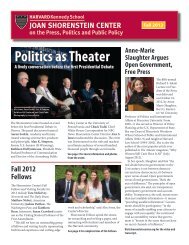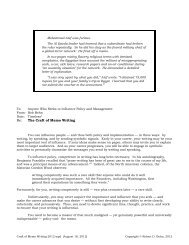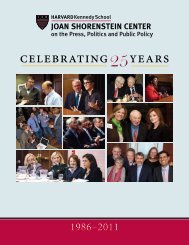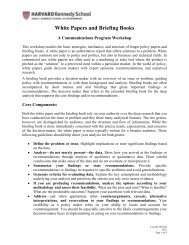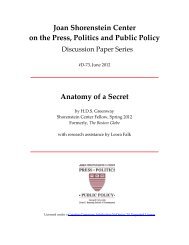A User-First Framework for Sustaining Local News - Harvard ...
A User-First Framework for Sustaining Local News - Harvard ...
A User-First Framework for Sustaining Local News - Harvard ...
You also want an ePaper? Increase the reach of your titles
YUMPU automatically turns print PDFs into web optimized ePapers that Google loves.
examples of successful entrepreneurs in this segment interested in tweaking their<br />
business models to direct some of that government news to a wider audience of users. In<br />
Denmark, <strong>for</strong>mer TV reporter Rasmus Nielsen makes available, without charge, a<br />
portion of his niche reports about the Danish Parliament to a general readership. 51 Craig<br />
Sandler, who publishes similar, high‐priced services tracking state government in<br />
Florida and Massachusetts, is also working on a consumer edition with more modest<br />
fees. 52<br />
Foundations have been helpful in encouraging nonprofit initiatives aimed at filling<br />
some of the gaps users are finding in government news and in<strong>for</strong>mation as a result of<br />
cutbacks. Sites like Connecticut Mirror, which launched in January 2010, are also taking<br />
significant strides in making sense of government reporting. Among its features: An<br />
Editor’s Choice service that provides users with a one‐stop aggregation of news about<br />
government and politics throughout the state, similar to Jim Romenesko’s news about<br />
news on Poynter Online. Connecticut Mirror says it does not anticipate charging users. 53<br />
Among the paid content experiments in the entertainment area was the 2003<br />
decision by The Los Angeles Times to put its popular CalendarLive entertainment section<br />
behind a pay wall. In a mini case study of the initiative, the Nieman Journalism Lab’s<br />
Tim Windsor reported that the move generated about $63,000 from the $39.95‐a‐year<br />
subscription fee and attracted about 19,000 registered users, 15,000 of them print<br />
subscribers who paid no online fee. Windsor noted an audience drop from 729,000<br />
visitors in July 2003 to the 19,000 registered visitors after the subscription requirement<br />
was imposed. Losses in ad revenue were not reported, but The Times removed the pay<br />
wall about 21 months after it went up. “If it was a success,” he added, “there was never<br />
a press release heralding that fact.” 54<br />
The latest test of the paid content model is underway on Long Island, where <strong>News</strong>day<br />
installed a $5 per week subscription fee in November 2009. Two months after imposing<br />
the pay wall, <strong>News</strong>day reported that only 35 people had purchased an online‐only<br />
subscription. The idea of the pay wall in this case, though, is not generating new<br />
revenue from out‐of‐market customers but securing the site’s value to users on Long<br />
Island. 55<br />
16




